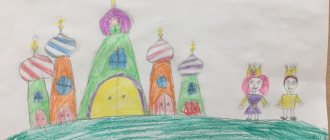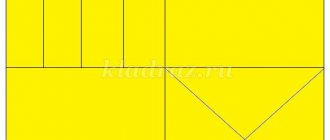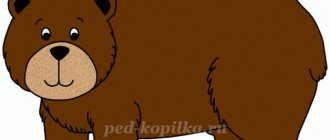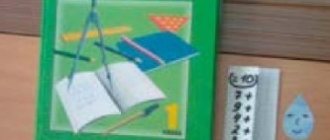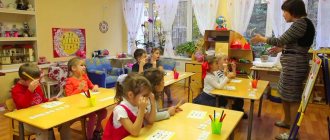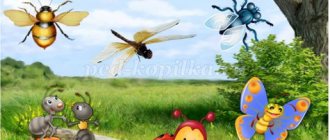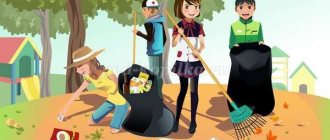Notes on mathematics in the preparatory group of preschool educational institutions. Count within 10
Summary of a mathematics lesson in the preparatory group “Journey to the Queen of Numbers.”
Author: Alexandra Nikolaevna Smirnova, teacher at MBDOU “Kindergarten No. 104”, Ivanovo
Lesson topic: “Journey to the Queen of Numbers.”
Goals : To consolidate the ability to use quantitative and ordinal counting within 10. Objectives: Educational:
• - Practice counting within 10 in forward and reverse order;
• — consolidate the concepts: “previous”, “next”, “neighbors” of the named number; • — Consolidate knowledge about the sequence of days of the week and seasons. Developmental:
• develop attention, imagination, creativity, speech.
Educational:
• - Cultivate a friendly attitude towards each other, a sense of mutual assistance.
• — To develop independence, the ability to understand a learning task and carry it out independently. • — Cultivate interest in mathematical studies. Preliminary work with children: • Guessing riddles, solving logical problems, solving simple arithmetic problems. Equipment: - cards with tasks, a checkered sheet of paper and a pencil according to the number of children, counting sticks, a chest with a surprise.
Course of the lesson:
Educator: Do you guys like traveling? (Children's answers). Today we will go on a journey to the Queen of Numbers. She needs our help, because evil robbers have stolen 3 numbers. Shall we help the Queen find them? (children's answers). Interesting tasks will await us. You will have to show your knowledge, skills and intelligence. Are you ready to go on this exciting journey? (children's answers) Educator: Well done! And now you will find out how we will get there. Guys, each of you has a sheet of paper with dots and numbers on your table. Your task is to connect the numbers in the correct order. (train)
What did you get? (compare with a board). Well done! Let's go on a trip. Guys, while you and I are on the train to the Queen of Numbers, let's tune in and practice. Let's get ready? First, let's remember: - Guys, what day of the week is it today? (Thursday) - What day of the week was yesterday? (Wednesday) - What day of the week will it be tomorrow? (Friday) - How many days are there in the week? (seven) - What days are the weekends? (Saturday and Sunday) How many seasons are there (4) How many months does each season have (3) How many months are there in the year (12) Now, I will name a number of words, and you will have to name the extra word. Winter, Wednesday, spring, summer, autumn (Wednesday) One, two, three, circle, four (circle) Plus, minus, Friday, equal (Friday) And now I will ask questions, listen carefully. If the table is higher than the chair, then the chair? (Below the table) If the road is wider than the path, then is it a path? (Already roads) If the ruler is longer than the pencil, then the pencil? (Shorter than a ruler) If the rope is thicker than the thread, then the thread? (Thinner than a rope) If a sister is older than a brother, then is the brother? (Younger than sister) Educator: Well done guys! Well, here we are. See the letter here. Let's read it. "Letter. Dear Guys! I have a problem, evil robbers stole my numbers, without them I can’t build a number series, I hope that you will help me find the missing numbers. The robbers have prepared tasks for you and said that for each correct solution of the tasks they will return numbers. I hope for your help, I can’t do it alone.” Educator: Guys, can we help the Queen? (children's answers) And so, the first task: The robbers have prepared problems for us, let's solve them: A puppy is sitting on the porch, warming his fluffy side. Another one came running and sat down next to him. How many puppies are there? (2) Antoshka fell into the snow, followed by Irinka. And behind her is Seryozhka, and behind him is Marinka. And then Ignat fell. How many children are there in the snow? (5) Grandma Masha has a grandson, Fyodor the Cat Pushok. Dog Buddy. How many grandchildren does grandma have? (1) 4 birds are sitting on a tree: 2 sparrows, the rest are crows. How many crows? (2) There were 6 mushrooms in the basket, 1 mushroom turned out to be inedible and was thrown away. How many mushrooms are left? (5) 5 roses bloomed on the bush. Mom cut 3 pieces, how many are left? (2) There were 5 red cups and 1 blue cup on the shelf. How many cups were there? (6) There are 8 tomatoes ripe on the bush. Four tomatoes were picked. How much is left? (4) Educator: Guys, it says here that if we solve the last problem correctly, we will get the first number that was stolen by the robbers. Listen carefully. Mom put cabbage pies in the oven. For Natasha, Kolya, Vova, the pies are already ready, and the cat dragged one more pie under the bench. Moreover, Mom needs to take five out of the oven. If you can, help - Count the pies! (9) Educator: Well done guys, you completed this task, and the robbers return one number to us. Now let's rest a little and move on. Physical education lesson: Let's jump and gallop! One two three four five! Let's jump and jump! (Jumping in place.) The right side bent. (Tilts the body left and right.) One, two, three. Left side bent. One two Three. Now let’s raise our hands (Hands up.) And reach for the cloud. Let's sit on the path, (Sit down on the floor.) We'll stretch our legs. Let's bend our right leg, (Bend our legs at the knee.) One, two, three! Let's bend the left leg, One, two, three. They raised their legs high (Raised their legs up.) And held them for a while. They shook their heads (Move their heads.) And everyone stood up together. (They stood up.) Educator: Well, you and I have had a little rest, we need to move on. Look at the tables, the robbers have prepared another task for you, if you solve it correctly, they will return another number to us. Ready? (children's answers) “Composition of numbers.” Guys, each of you has pictures of houses, in each house there are as many residents as are indicated on the roof, for example, 7 residents live in a house, 5 have already moved in, how many people will live in another apartment? (2). Guys, do you understand the task? (children's answers). Children complete tasks, composition of numbers.
Educator : Well done guys, you completed this task too, the robbers are returning another number to us. Warm-up: Now all the children should stand up, slowly raise their hands, clench their fingers, then unclench their hands, hold their hands down and stand like that. We all rested a little (lean forward and shake our arms) and went on the path. (steps in place or in a circle) Educator: Guys, we have already returned two numbers to the Queen of Numbers, we have one last task left, is everyone ready to cope with it? (children's answers) Look at the geometric shapes on our table, we need to build a house from them, but not just build, first we need to guess, and only then build our house. 1. Four corners and four sides, They look exactly like sisters. You can’t roll him into the goal like a ball, And he won’t start galloping after you. The figure is familiar to many guys. Did you recognize him? After all, this is... (Square)
Let's put a square. This will be the foundation of our house. 2. My three sides can be of different lengths. Where the sides meet - the angle is obtained. What happened? Look! After all, there are also three corners. Look at me, say my name. (Triangle)
We put a triangle. This is the roof of our house. 3. We stretched the square and presented it to the eye, Who did it look like or something very similar? Not a brick, not a triangle - Became a square... (rectangle)
Let's create a rectangle. This will be the pipe for our house. — What else is missing in our house? (doors and windows) 4. I have no corners And I look like a saucer, Like a medal, like a pancake, Like an aspen leaf. I am an old friend to people. They call me (circle)
Let's make a circle. Guys, let's take two circles, these will be our windows. 5. Trace the whole brick with chalk on the asphalt, And you will get a figure - You, of course, are familiar with it. (Rectangle)
Let's create a rectangle. This will be the door for our house. Let's see what we got
- Well done guys, you completed all the tasks that the robbers prepared for you, and the Queen of Numbers wants to thank you. Letter from the Queen of Numbers. "Dear friends! Thank you so much for your help! You did an excellent job with all the tasks. Absolute precision and order reign in my mathematical kingdom. You, my young mathematicians, in gratitude from all the inhabitants of my country and from me personally, are awarded gold medals for your intelligence, ingenuity and determination!”
We recommend watching:
Summary of GCD for children of the preparatory group. How to be able to count well Mathematics lesson in the preparatory group. Notes Notes of the final lesson in mathematics in the preparatory group Notes of OD on FEMP in the preparatory group “Journey into the world of mathematics”
Similar articles:
Summary of mathematics lessons in the preparatory group. Pentagon
Summary of mathematics lessons in the preparatory group. Repetition of what has been learned in the senior group
Abstract of GCD in mathematics in the preparatory group. Solving logical problems
Abstract of GCD in mathematics in the preparatory group on the topic: Area
Abstract of GCD in mathematics in the preparatory group. Tangram
Summary of GCD in the preparatory school group for FEMP
Abstract of the GCD in the preparatory group for FEMP for compliance with the logic of the system-activity approach.
Description: I bring to your attention a summary of the GCD in the preparatory group for FEMP for compliance with the logic of the system-activity approach. This material will be of interest to educators and senior educators. Topic: Formation of elementary mathematical concepts: clarify the idea of coins in denominations of 1, 2, 5 and 10 rubles, their collection and exchange; practice the ability to form a number from two smaller numbers and decompose the number into two smaller ones. Educational area : Cognitive development. Integration O.O.: Social and communicative development, speech development, physical development, artistic and aesthetic development. Educational tasks: • formation of elementary mathematical concepts: clarify the idea of coins in denominations of 1, 2, 5 and 10 rubles, their collection and exchange; practice the ability to form a number from two smaller numbers and decompose the number into two smaller ones. • Improve counting skills. Developmental tasks: • Develop attention, logical thinking, speech, fine motor skills, perseverance, memory. Educational tasks: • Develop the ability to listen to the opinions of others, listen carefully to the teacher’s questions and each other’s answers; • Develop the ability to work independently; • Develop skills of mutual control and self-control; • Foster a desire to help fictional characters; • Foster a desire to work together. Didactic games: • “Keep counting” • “True - false” Purpose: repeat counting, adding numbers, comparing numbers. Introduction to the situation
The teacher and children stand in a circle.
Q: Guys, we have received a package. Let's see what's in this package. She is very heavy. Oh, the package is filled with a good mood, now I’ll take it and share it with all of you, catch the good mood with your palms. Oh, there's something else in the package. What is this? Children's answers. Envelope with a letter. -Let's see who the letter is from and what is written in it? Open the letter. Q: This is a letter from Pinocchio, who sends us a bag of coins and asks us to help. He needs to buy the alphabet for him and his friends. But he doesn’t know how to count at all and has never bought anything before and therefore is afraid. Pinocchio wants us to buy the alphabet. What denominations of coins do you already know? Children's answers.
- Well, guys, do you want to help Pinocchio?
Children's answers.
- After all, you and I have already learned to count a little.
Children's answers.
-Do you think you can help him?
Children's answers. Actualization - Well, in order to help Pinocchio, we have to get to the bookstore. What type of transport is available in our area? Where should I wait for the bus? Children's answers.
— Guys, while you and I are waiting for the bus at the stop, we will repeat the count and play the game “Continue counting to 10.”
(The children form a circle, the teacher with the ball in the center. He throws the ball to the children one by one and names the number. The children must continue counting to 10, starting with the number named by the teacher. And then throw the ball back to the teacher.) - So our bus has arrived? Guys, what do we need to get us there? Children's answers.
-Take each a coin to pay the fare and take a seat on the bus.
During the journey, do not play around or make noise so as not to disturb other passengers. -We will be traveling with you for some time and so that we don’t get bored, let’s play the game “True or False.” (I say a statement, for example, 2 is more than 1. If the children agree with it, then they clap their hands, if they don’t agree, then they stomp their feet.) Difficulty in the situation
- Guys, now we have reached the final stop.
Bus travel costs 3 rubles, you need to pay. What coin do you and I have? Enough for you to pay? And why? Children's answers. -I'll go first. Guys, the driver says he doesn’t have change. And you and I have no other coins. What should we do? Discovery of a new way Children's answers.
Children try to guess or ask someone who knows.
-You need to try to exchange a 10 ruble coin from someone for smaller coins. — Guys, one of the passengers has a lot of smaller coins, he agreed to exchange our 10 ruble coins for smaller ones if you help him count. -What methods of exchange did you manage? Children's answers Contents of the work to incorporate new knowledge - Now we will play with you the game “Seller and Buyer” - I will now be in the role of the seller, and you will be the buyers. I will sell you candies, each candy has its own price. Prepare the money for me, according to the price indicated, and place it on the edge of the table. I will go past each one and check that your calculations are correct. - And now I will become the buyer, and you will become the sellers. I give each of you a coin worth 10 rubles and buy a toy from you, and you give me change. - And now I will ask you to exchange a 5 ruble coin for me with smaller coins. - Well, now we can go buy the alphabet. After all, today we learned how to exchange a large coin for smaller ones and can collect coins from smaller ones. The alphabet costs 7 rubles, please have some coins ready. - Well, we bought the alphabet for Pinocchio and his friends. And since we bought the alphabet, that means we could help Pinocchio? Why do you think? Children's answers After going to the store, you are probably tired, let's warm up a little. Physical exercise One - rise, stretch, Two - bend, straighten, Three - three claps of the hands, three nods of the head. On four - arms wider, five - wave your arms, six - sit on the chair again. Reflection
-Where have we been? What did we do today, who did we help, how did we succeed, what did we do to achieve the goal, what knowledge was useful to us? Children's answers. -Well, did you guys like today’s lesson? Children's answers. -And now I suggest we play “Mint” and make coins for the game by placing a sheet of paper on the coin, and carefully shade it with a pencil, then cut out a circle along the contour of the coin.
We recommend watching:
Lesson notes on FEMP for the preparatory group. Solving GCD problems in mathematics in a preparatory group in kindergarten Synopsis of a game GCD in mathematics for children of the preparatory group of a preschool educational institution Synopsis of an integrated GCD for FEMP for a preparatory group for the Federal State Educational Standard
Similar articles:
Summary of a mathematics lesson in the preparatory group of a preschool educational institution on the topic: Hexagon
Abstract of GCD in mathematics in the preparatory group. Composition of number 5
Abstract of GCD in mathematics in the preparatory group. Converting Shapes
Abstract of GCD in mathematics in the preparatory group on the topic: Counting forward and backward
Summary of a mathematics lesson in the preparatory group of a preschool educational institution on the topic: Composition of the number 10
“Counting objects within 10. Orientation in space.”
Municipal preschool educational institution "Kindergarten No. 341 of the Dzerzhinsky district of Volgograd"
Summary of educational activities on cognitive development in the senior group
SUBJECT:
«Counting objects within 10. Orientation in space
».
Compiled by:
teacher Nikitina Elena Valentinovna
Volgograd
2019
Task: counting objects up to 10 according to the pattern
,
orientation in space
.
Goals:
develop an idea of
that
objects
can be counted in any direction;
practice counting objects
, located differently;
strengthen counting skills within 10
;
practice counting by ear
, learn to establish connections between many sounds and many visually perceived
objects
;
teach children to find a location (right, left, behind, in front)
; learn to separate parts from the whole.
Demonstration material: numbers from 1 to 10, 10 carrots, toy hare, board
Handouts: cards with loose stripes, geometric shapes (9-10 for each child, notebook for each child, colored pencils.
Progress of the lesson
The teacher carries numbers from 1 to 10 and “accidentally” scatters them.
— Invites the child to put them in the right order. Let's check if...we've laid them out correctly.
- Closed your eyes. Which number has disappeared? (repeated two or three times).
- Tell me the neighbors of the numbers (2, 6, 8).
- Well done, you know how to count well.
— The teacher says that a hare has come to visit, he loves carrots very much, but he doesn’t know how to count, and invites all the children to count together how many carrots there are. (10)
. What if we count them from left to right? There will also be 10 of them.
Until now, we have been counting objects, toys and other things, placing them in a row. Is it possible to count objects when they are not arranged in a row?
The teacher puts in front of the children the “Smart Panels” manual, on which the nesting dolls are displayed in a circle.
Look, I arranged the nesting dolls in a circle, as if they were dancing in a circle. How many are there? (One of the children counts the nesting dolls and names their number.)
Which nesting doll did you start counting with? Is it possible to start counting from another matryoshka?”
Two children take turns counting the nesting dolls again, starting with a different toy each time. Find out whether the resulting numbers are the same. If children make mistakes, determine the cause of the mistakes. The teacher concludes: “ You can start counting with any subject.”
, the answer will be the same."
Dynamic pause (card index)
Now let's sit down at the tables.
Now I suggest you count the sounds . “Listen carefully to how many times the tambourine strikes”

